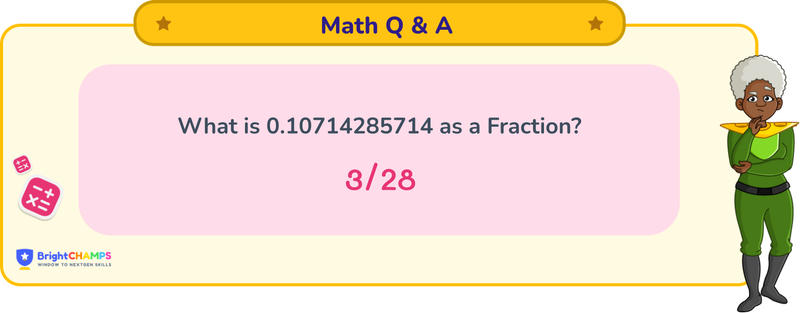
 136 Learners
136 LearnersLast updated on May 26th, 2025

0.10714285714 as a Fraction

Numbers can be categorized into different types. Fraction is one of its kind. It is always represented in the form of p/q, where p is the numerator and q is the denominator. Fraction represents a whole and a fractional part. Decimals represent the fractional part of numbers. For example, 1/2, the numbers in decimal are expressed with a decimal point (.), For example, 0.10714285714, we are going to learn how to convert a decimal to a fraction.
What is 0.10714285714 as a Fraction?
![0.10714285714 as a fraction]() Answer
Answer
The answer for 0.10714285714 as a fraction will be 3/28.
Explanation
Converting a decimal to a fraction is a task for students that can be done easily. You can follow the steps mentioned below to find the answer.
Step 1: Firstly, any decimal number should be converted to fraction for easy calculation. Here, 0.10714285714 is the number on the numerator and the base number 1 will be the denominator. Then, 0.10714285714 becomes 0.10714285714/1.
Step 2: To remove decimal from a fraction, you need to multiply both the numerator and denominator by 100000000000 (because there are 11 decimal places). 0.10714285714/1 × 100000000000/100000000000 = 10714285714/100000000000
Step 3: Here 3571428571 is the GCD of 10714285714 and 100000000000. Now, to make the fraction simpler, divide the numerator and denominator by 3571428571. 10714285714/100000000000 = 3/28 Hence, 0.10714285714 is in the form fraction of 3/28.
Thus, 0.10714285714 can be written as a fraction 3/28.
Struggling with Math?
Get 1:1 Coaching to Boost Grades Fast !

Important Glossaries for 0.10714285714 as a Fraction
Fraction: A numerical quantity that is not a whole number, representing a part of a whole.
Decimal: A number that uses the base ten and includes a decimal point to separate the whole part from the fractional part.
Numerator: The top part of a fraction, indicating how many parts of the whole are being considered.
Denominator: The bottom part of a fraction, showing how many parts make up a whole.
Terminating Decimal: A decimal that ends and does not repeat infinitely.

 Answer
Answer


